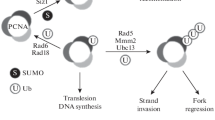Abstract
The OGG1 gene of Saccharomyces cerevisiae encodes a DNA glycosylase that excises 7,8-dihydro-8-oxoguanine (8-OxoG) and 2,6-diamino-4-hydroxy-5-N-methylformamidopyrimidine. To investigate the biological role of the OGG1 gene, mutants were constructed by partial deletion of the coding sequence and insertion of marker genes, yielding ogg1::TRP1 and ogg1::URA3 mutant strains. The disruption of the OGG1 gene does not compromise the viability of haploid cells, therefore it is not an essential gene. The capacity to repair 8-OxoG has been measured in cell-free extracts of wild-type and ogg1 strains using a 34mer DNA fragment containing a single 8-OxoG residue paired with a cytosine (8-OxoG/C) as a substrate. Cell-free extracts of the wild-type strain efficiently cleave the 8-OxoG-containing strand of the 8-OxoG/C duplex. In contrast, cell-free extracts of the Ogg1-deficient strain have no detectable activity that can cleave the 8-OxoG/C duplex. The biological properties of the ogg1 mutant have also been investigated. The results show that the ogg1 disruptant is not hypersensitive to DNA-damaging agents such as ultraviolet light at 254 nm, hydrogen peroxide or methyl methanesulfonate. However, the ogg1 mutant exhibits a mutator phenotype. When compared to those of a wild-type strain, the frequencies of mutation to canavanine resistance (CanR) and reversion to Lys+ are sevenfold and tenfold higher for the ogg1 mutant strain, respectively. Moreover, using a specific tester system, we show that the Ogg1-deficient strain displays a 50-fold increase in spontaneously occurring G · C→T · A transversions compared to the wild-type strain. The five other base substitution events are not affected by the disruption of the OGG1 gene. These results strongly suggest that endogeneous reactive oxygen species cause DNA damage and that the excision of 8-OxoG catalyzed by the Ogg1 protein contributes to the maintenance of genetic stability in S. cerevisiae.
Similar content being viewed by others
Author information
Authors and Affiliations
Additional information
Received: 6 September 1996 / Accepted: 22 October 1996
Rights and permissions
About this article
Cite this article
Thomas, D., Scot, A., Barbey, R. et al. Inactivation of OGG1 increases the incidence of G · C→T · A transversions in Saccharomyces cerevisiae : evidence for endogenous oxidative damage to DNA in eukaryotic cells. Mol Gen Genet 254, 171–178 (1997). https://doi.org/10.1007/s004380050405
Issue Date:
DOI: https://doi.org/10.1007/s004380050405




